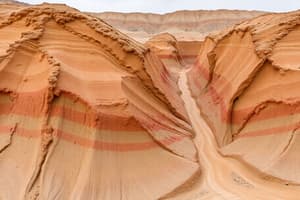Podcast
Questions and Answers
What is the opposite process of deposition?
What is the opposite process of deposition?
- Sedimentation
- Erosion (correct)
- Weathering
- Glaciation
Which type of deposition occurs when wind blows desert sand upwards and deposits it into mounds?
Which type of deposition occurs when wind blows desert sand upwards and deposits it into mounds?
- Fluvial deposition
- Aeolian deposition (correct)
- Debris flow deposition
- Glacial deposition
What type of material is deposited by glaciers as they melt?
What type of material is deposited by glaciers as they melt?
- Sand
- Sediment and water
- Alluvium
- Rocks and boulders (correct)
What is the term used to describe the process where large amounts of sediment combine with water and flow together before settling?
What is the term used to describe the process where large amounts of sediment combine with water and flow together before settling?
What type of materials undergo physical, chemical, and biological changes, leading to erosion and subsequent deposition?
What type of materials undergo physical, chemical, and biological changes, leading to erosion and subsequent deposition?
What is the main process that breaks down rocks and geological materials into smaller pieces?
What is the main process that breaks down rocks and geological materials into smaller pieces?
Which type of erosion occurs when wind lifts and transports dust, sand, gravel, or small rocks?
Which type of erosion occurs when wind lifts and transports dust, sand, gravel, or small rocks?
Which type of erosion contributes to the formation of valleys and fjords?
Which type of erosion contributes to the formation of valleys and fjords?
What is the process of removing surface materials from one location and transporting them to another place called?
What is the process of removing surface materials from one location and transporting them to another place called?
Which type of erosion occurs when water carries away the top layer of soil or rock, often during heavy rainfall?
Which type of erosion occurs when water carries away the top layer of soil or rock, often during heavy rainfall?
What happens when rocks fall off cliffs or slide on hilly slopes after being loosened by forces like rainwater or plant roots?
What happens when rocks fall off cliffs or slide on hilly slopes after being loosened by forces like rainwater or plant roots?
Flashcards are hidden until you start studying
Study Notes
Erosion and Deposition of Weathering Products
Weathering is the natural process of breaking down rocks and other geological materials into smaller pieces due to environmental factors such as temperature, moisture, wind, and water. This process results in various weathered material products such as rock fragments, soil particles, and clay. These products can be transported through different means and eventually get eroded or deposited in new locations. In this article, we will discuss the processes of erosion and deposition of weathering products, their types, and examples of these phenomena.
Types of Erosion and Deposition
Erosion
Erosion refers to the removal of surface materials from one location and the transportation of those materials to another place due to agents like water, wind, ice, or gravity. There are two main types of erosion:
-
Water erosion: Also known as hydrology, it occurs when water carries away the top layer of soil or rock, often during heavy rainfall. For example, riverbank erosion.
-
Wind erosion: Occurs when wind lifts and transports dust, sand, gravel, or small rocks. Examples include desert dunes.
-
Ice erosion: Happens when glaciers move over land, carrying rocks along and grinding them against each other. This type of erosion also contributes to the formation of valleys and fjords.
-
Gravity erosion: Due to gravity, rocks fall off cliffs or slide on hilly slopes after being loosened by forces like rainwater or plant roots. An example is mass wasting.
Deposition
Deposition is the opposite process, where materials are dropped from a moving agent such as water, wind, or ice, and accumulate at a new location. Here are some common types:
-
Fluvial deposition: Materials deposited along rivers and streams form alluvium.
-
Aeolian deposition: Sand dunes form when wind blows desert sand upwards and deposits it into mounds.
-
Glacial deposition: As glaciers melt, they deposit debris such as rocks and boulders, creating moraines.
-
Debris flow deposition: During flood events, large amounts of sediment can combine with water and flow together before settling.
In conclusion, weathering products like rocks, soils, and clay undergo physical, chemical, and biological changes, leading to erosion and subsequent deposition elsewhere. Understanding these processes provides valuable insights into earth's dynamics and helps us manage resources more effectively.
Studying That Suits You
Use AI to generate personalized quizzes and flashcards to suit your learning preferences.



